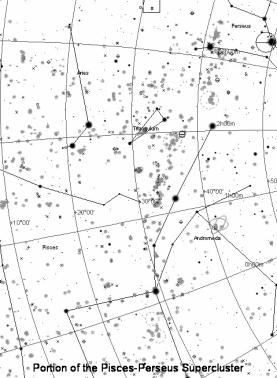Cosmographic Observing
Jack Kramer
Cosmography in its simplest terms means the study of the arrangement of objects in the universe on a grand scale. From this comes our knowledge of sheets and walls of galaxies, voids, and the "Great Attractor". Cosmography is not something that amateur astronomers generally dabble in, but we can observe some of those objects that have given cosmologists insight into the layout of the universe.
I first thought about my own observations of these objects when reading Ken Croswell's book The Universe at Midnight. In there he relates that the first inkling of a "supercluster" of galaxies came in 1932 when the astronomer Walter Bernheimer counted a concentration of 117 NGC objects in a sweep starting in the great square of Pegasus and passing through Pisces, Andromeda, Triangulum, and ending behind the obscuring cloud of the Milky Way in Perseus. It's now known as the Pisces-Perseus supercluster, 270 million light years from Earth. In the chart section from the Cartes du Ciel program shown here, note the concentration of galaxies in this area of the sky. (The gray dots are galaxies.) It doesn't take much imagination to visualize a wall of galaxies.
 Since many of them are fainter than 13th magnitude, those will be difficult, if not impossible, for smaller telescopes. However, there are also many that are easily accessible to us. As you hop from one galaxy to another in this area of the sky, recall that you are not just looking at a cluster of galaxies, but a supercluster!
Since many of them are fainter than 13th magnitude, those will be difficult, if not impossible, for smaller telescopes. However, there are also many that are easily accessible to us. As you hop from one galaxy to another in this area of the sky, recall that you are not just looking at a cluster of galaxies, but a supercluster!
In the 1950's, Gerard de Vaucouleurs identified what he called the "Local Supercluster", of which the Milky Way is a member. One end is in the constellations Cassiopeia and Camelopardalis, then proceeds through Ursa Major, Canes Venatici, Coma Berenices and Virgo, then south into Hydra and through Centaurus, Circinus, Pavo, Tucana, then turning back north through Grus, Phoenix, Sculptor, Cetus, Pisces, Andromeda, and finally back to Cassiopeia. Within this Supercluster are smaller groups of galaxies, plus some of the showpiece objects we routinely observe with our own telescopes - the M81 group, M101, M51 and M63 in Canes, the Virgo cluster of galaxies, M83, Centaurus A, M74, and M31. The disk containing the Milky Way is referred-to as the "galactic plane"; de Vaucouleurs coined the term "supergalactic plane" for the disk of the local supercluster. Additional galaxy clusters have been identified, but this is probably the easiest for us to view.
Voids - a lack of galaxies in certain places - are a relatively recent discovery, since it was not until the 1970's that astronomers were able to determine the red shifts of more distant objects. While working on his doctorate, Steve Gregory studied the distances of galaxies in the Coma Cluster and discovered that there were no foreground galaxies; that is, galaxies that lie between us and the Coma Cluster. So when we observe galaxies in the Coma Cluster in the springtime sky, we're looking across a cosmographic void.
So get out your star charts and plan your galaxy hunt - you're observing on a cosmographic scale!
Published in the December 2005 issue of the NightTimes




